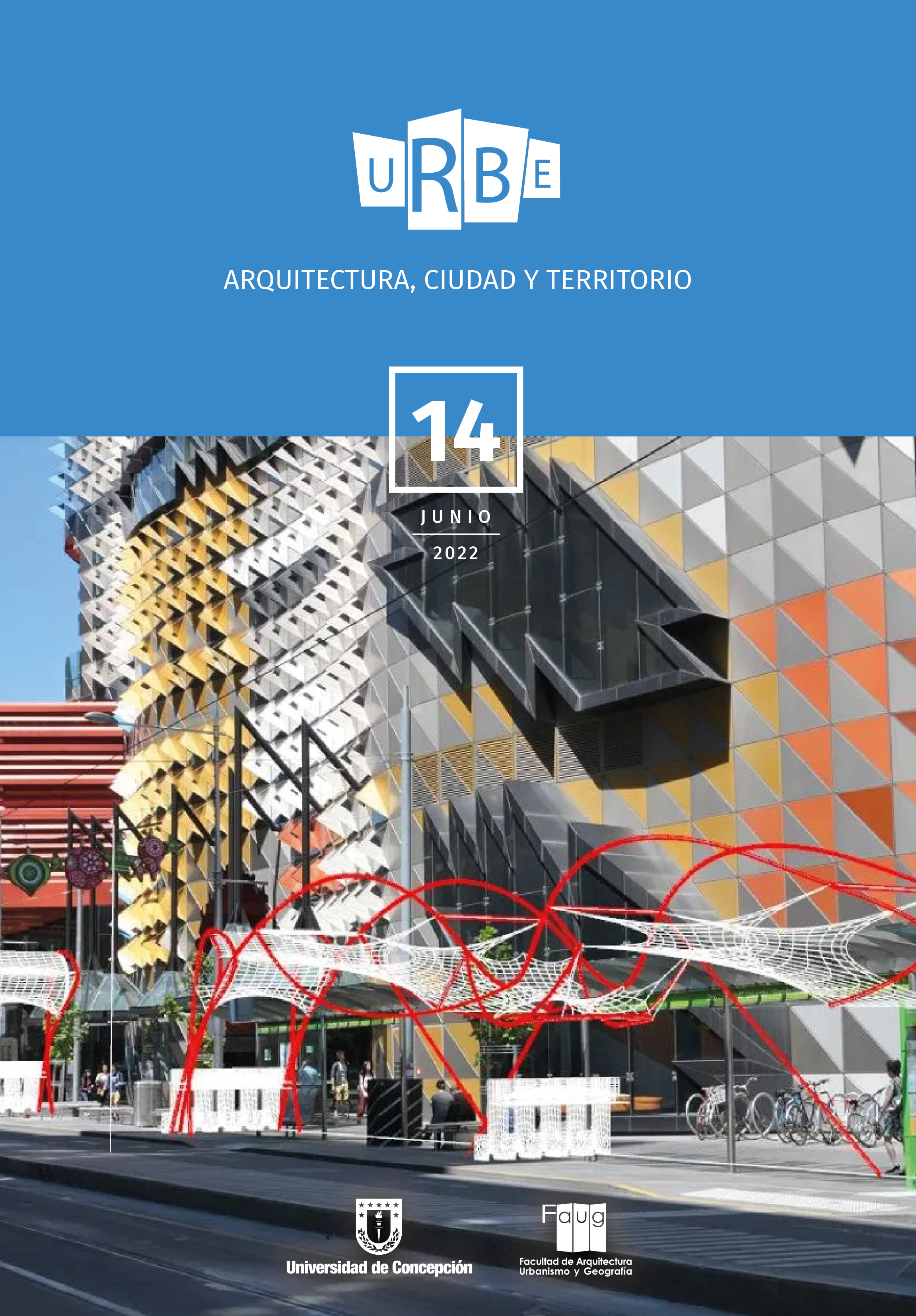Disarticulation of the city-port assembly in intermediate-scale systems. Process and alternatives for Lebu, Biobío Region.
DOI:
https://doi.org/10.29393/UR14-6DCDM20006Keywords:
Port-city relationship, urban disarticulation, port reconversion, urban morphologyAbstract
The relationships between cities and their ports (Hoyle, 2000), depend on changes in both spaces. In Lebu –an intermediate city and capital of the province of Arauco, Biobío Region, Chile–, the artisanal port has moved from its original position to an area far from the historic center, abandoning infrastructures, which has deteriorated the coastline, such as traditional public space. The article investigates the causes and effects of this process, from the premise that the port transfer not only produces abandonment of spaces, but also of flows and daily practices of use, which dismantle the city-port-coastal border relationship. For this, the process of emergence, growth and transfer of the port was analyzed, delving into the relationship between the growth of the city, changes in its spatial and functional relationship with the port, and the role of public space in this process.
The methodology is mixed, with quantitative analysis of secondary sources –Territorial Planning Instruments, books, cartographies and historical images–, and qualitative –photographic suvey, interpretive cartographies–, which allowed to identify the evolution and modifications in significant spaces for the port-town relationship.
The analysis showed that in Lebu, the city and the port were not born spatially united, but that the relationship between the two has been fluctuating between distancing and approaching. The original port, on the edge of the sea, served mining, and when it declined, it was moved to the south bank of the river to support artisanal fishing, and then to the north bank, for semi-industrial fishing. This successive process of relocation implied the abandonment of port areas and breaks in the relationship between the city and the port. Despite this, the river is still home to traditional trades such as riverbank carpentry, which can contribute to revaluing the port-city relationship and contribute to strengthening urban identity.
Downloads
References
Alarcón, M. (2009). Reordenación del frente portuario de Valparaíso. Oportunidad de rearticulación puerto-ciudad. Cuaderno Urbano. 8(8), 205-226.
Alarcón, M. y Sandoval, P. (2016). “Transformación del frente portuario de Talcahuano: oportunidades para la integración urbana”. Cap. en: Hidalgo, R. et al (Eds). En las costas del neoliberalismo. Santiago de Chile. Editorial: Instituto de Geografía PUCCh.
Alarcón, M.; Toro, S. (2020). Innovación social en ciudades portuarias de Chile. Santiago de Chile. Editorial: RIL.
Alemany; J. (1991). Los puertos españoles en el siglo XIX. Estudios Históricos de Obras Públicas y Urbanismo, Madrid: Secretaría General Técnica, Centro de Publicaciones del MOPT, 1991.
Alemany, J. (2015). “Incidencia del puerto en la ciudad. La experiencia latinoamericana de renovación de los waterfronts. Revista Transporte y territorio. pp. 70 - 86. Universidad de Buenos Aires. https://www.redalyc.org/pdf/3330/333039205005.pdf
Bird, J. (1963). The Major Seaports of the United Kingdom. London: Hutchinson. ISBN: 9780090662623.
Boix, M. (2017). Análisis teórico y práctico del concepto Puerto-Ciudad. Master en gestión portuaria y transporte intermodal. Madrid: Icade business school. Disponible en: https://repositorio.comillas.edu/xmlui/bitstream/handle/11531/25014/TFM000842.pdf?sequ ence=1
Borja, J. y Muxí, Z. (2003). El espacio público, ciudad y ciudadanía. Electa.
Busquets, J. (1990). Los frentes de agua españoles. PORTUS N° 1, (pp: 52-59). RETE digital: http://retedigital.com/wp-content/themes/rete/pdfs/portus/Portus_1/A_renova%C3%A7%C 3%A3o_do_porto_de_Rio_de_Janeiro_e_seu_waterfront2.pdf
Dadón, J. (2020). Procesos de configuración de frentes urbanos costeros: La ribera de Buenos Aires (Argentina). Investigaciones Geográficas, (74), 223-243. Disponible en: https://doi.org/10.14198/INGEO2020.D
Eraso, M. (2009). Dossier Puerto y Territorio: análisis de lo global y debate de lo local. REMS-Revista de Estudio Marítimos y Sociales. Disponible en: https://estudiosmaritimossociales.org/wp-content/uploads/2016/05/rems-nc2ba-2-28x21-1 8-11-09_p125-134-2.pdf
Estrada, J. L. (2004). “El desarrollo portuario y la ciudad”. Ingeniería y territorio núm. 67. (Ejemplar dedicado a: frentes marítimos), 10-19.
Fedele, J.; Domínguez, L. (2015). Dossier Puerto y Ciudad. Revista Transporte y Territorio /12. (pp. 1-15). Universidad de Buenos Aires.
Fevre, R. y Dadón, J. (2011). Planificación y manejo costero integrado en espacios urbano-costeros de Argentina. Revista anual, 17.
García, A. (2009). Terminal Pesquero Regional en Lebu, Espacio Productivo Cultural. Memoria para optar al título de Arquitecto. Fau, U. de Chile, 2009. URI: https://repositorio.uchile.cl/handle/2250/112544
Grindlay, A. (2008). Ciudades y puertos. Ciudades, 11, (pp. 53-80). https://doi.org/10.24197/ciudades.11.2008.53-80
Hoyle, B. (1989). The port-city interface: Trends, problems and examples. Geoforum, 20(20), 429-436.
Hoyle, B. (2000). Global and Local Change on the Port – City Waterfront. Geographical Review, 90(3), 395-417.
Jacob, J, 1961. Vida y muerte de las ciudades. (pp. 45-48). Capitán Swing Libros.
Manero, F. (1985). Subdesarrollo y países subdesarrollados. Salvat Editores.
Muñoz, M. (2000). Ciudad y Memoria: el patrimonio industrial en Lota, Coronel, Tomé y Lebu. Concepción: Secretaría Ministerial de Educación Región del Bio-Bio y Universidad de Bío Bío.
Pizarro, A. (1993). De la Leufumapu a su centenario 1540-1962. Ñielol.
Pizzi, M. (2016). Valparaíso, ciudad Patrimonio de la Humanidad. Tensión entre su revitalización y la preservación de su identidad. PORTUS, 19, 28–31. https://portusonline.org/portus-19/?issues=42
Ruiz, J. (2016). Los espacios portuarios: naturaleza, paisaje y estructura. PORTUS N° 19, (pp: 28-31): RETE digital. Disponible en: https://portusonline.org/portus-19/?issues=42
Shaw, B. (2001). “History at Water’s Edge”. En: Marshall, R. (Ed.) Waterfronts in Postindustrial Cities. New York: Spon Press, 160-161. ISBN: 9780203166895.
Sola-Morales, M. (1997). Las formas de crecimiento urbano. Ediciones UPC.
Talesnik, D. y Gutiérrez, A. (2002). Transformaciones de frentes de agua: la forma urbana como producto estándar. Revista Latinoamericana de Estudios Urbanos y Territoriales, 28(84), 21-31.
Valenzuela, C. y Pérez, L. (2010). Lebu: Minería del carbón y evolución urbana desde 1862 a la actualidad. Urbano, (13)21, 5–19.
Zárate, A. (1991). El espacio interior de la ciudad. Colección Espacio y Sociedades, 12. Editorial Síntesis.
Published
How to Cite
Issue
Section
Copyright (c) 2022 Daniel Loaiza Valencia, Mabel Alarcón Rodríguez

This work is licensed under a Creative Commons Attribution 4.0 International License.
Revista URBE. Arquitectura, Ciudad y Territorio tiene licencia de Creative Commons Attribution 4.0 International (CC BY 4.0) y debe citarse correctamente.









